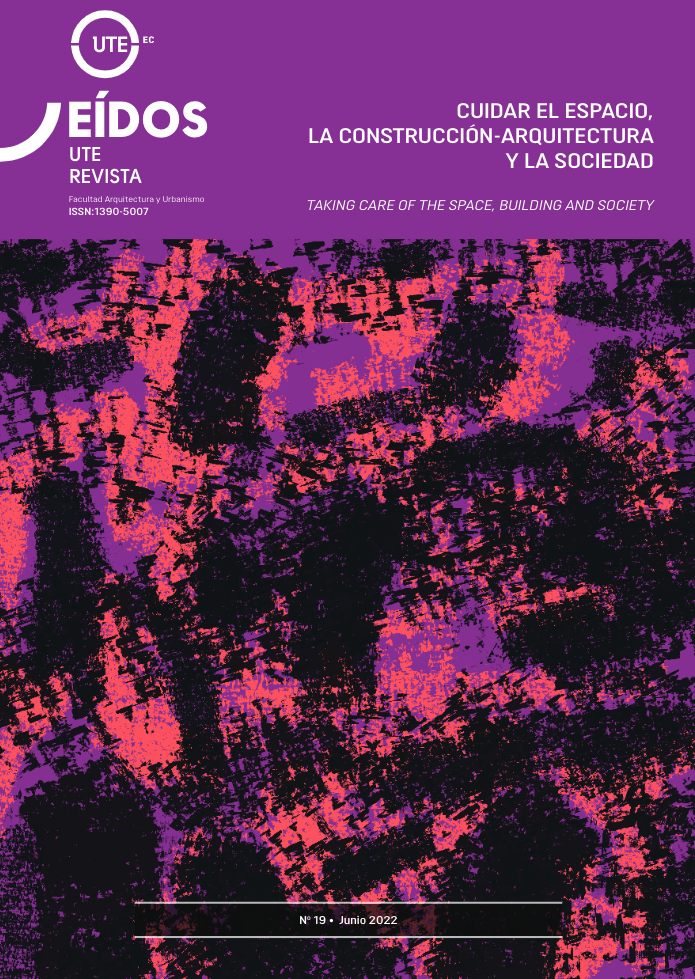Estudio comparativo de vitrales de colores en el arte gótico con la fabricación de ventanas (Orosi Sazi) en la era Qajar: estudio de caso de la Iglesia Charter y la mansión Salaar Saeid
DOI:
https://doi.org/10.29019/eidos.v14i19.998Palabras clave:
arte gótico, vitrales, arte Qajar, Orosi (sash)Resumen
En Europa, el uso de vitrales de colores en la construcción de ventanas de la iglesia era común, alcanzando su apogeo durante el período gótico. Por otro lado, la tendencia a usar vidrio de color, llamado Orosi (Sash), en la arquitectura iraní comenzó en la era safávida y, bajo la influencia de la cultura y el arte iraníes, se convirtió en un arte genuino llamado
azulejos Girih; este arte floreció sin precedentes durante la era Qajar. El presente estudio tuvo como objetivo identificar los vínculos interculturales en el arte de la era Qajar con elementos tomados de la cultura occidental y mediante la comparación de técnicas estructurales, color, patrones, y el impacto de factores conceptuales como la luz trata de identificar las posibles similitudes entre los dos métodos basados en la coincidencia de las muestras de estudio de sus dos estructuras sobresalientes (Iglesia Charter y Salaar Saeid Mansion). Especialmente en Irán, siendo un territorio que siempre está en el centro de los intercambios culturales, estudiar la relación entre esta tendencia en la arquitectura iraní y sus raíces puede ser útil para una mejor comprensión del arte iraní. El presente estudio es un caso práctico y a nivel
metodológico es un estudio descriptivo-analítico. Los datos se recogieron mediante un estudio documental (biblioteca). Los hallazgos han demostrado que la tradición de los vitrales ha existido más en tierras europeas, y su formación en Irán está más influenciada por los componentes culturales importados. Se puede afirmar que la fabricación de ventanas...
Descargas
Citas
Alam, N. I. (2003). Middle Eastern arts in the Islamic era. Translated by Abbas Ali Tafazli. Published.
Alizadeh Oskuei, P., et al. (2020). The Mystical Symbol of Light and Color in Gothic Painting and Architecture. Journal of Islamic Mysticism. (63): 41-53.
Alipour, N. (2011). Study of sash designs of Qajar palaces in Tehran. Ngarhe Quarterly. (18): 5- 21
Amrayi, M. (2012). Sash Windows Facing Light. Third Edition. SAMT.
Arjmandi, H; Mohd Tahir, M; Shabankareh, H; Shabani, M and Mazaheri, F (2011). Psychological and spiritual effects of light and color from Iranian traditional houses on dwellers, Journal of Social Sciences and Humanities. (6): 288-301.
Bani Massoud, A. (2015). Western architecture, roots, and concepts. Seventh Edition. Honar-e Memari Publication.
Bozorgmehri, Z., and Anahita Haddadi. (2010). Iranian studies (cognition, pathology, and restoration) Soroushe Danesh.
Bolkhari, H. (2015). Light in Architecture, Glitter of Meaning in Form. Light in Iranian Art, Architecture and Urban Planning, 1-16.
Carla Serna, Madame. (1983). People and religions in Iran. Translated by Ali Asghar Saeedi. First Edition. Zavar.
Chardin, Knight. (2014). Chardin Itinerary. Translated by Iqbal Yaghmaei. Vol. II. Second Edition. Toos.
Connell, Ernst. (2007). Islamic art. Translated by Houshang Taheri. Toos Publishing Davis, Danny et al. (2009). Janson's history of art. Translated by Farzan Sojud.
Dibaj, Seyed Musa. (2005). Light space and light architecture. Baghe Nazar Journal, 2 (3): 50-48.
Duman, Raphael. (1975). New Explanation of the East or the Principles of Religion, Administration and Customs of Iranians, Armenians and Zoroastrians. First Edition. University of Tehran.
Durandus, William. (1843). Rationale divinorum officiorum, 1.1.24. Translated by John Mason Neale and Benjamin Webb, The Symbolism of Churches and Church Ornaments. Leeds: T.W. Green.
Ettinghausen, Richard and Graber, Alg (2015). Islamic Art and Architecture. Translated by Yaghoub Azhand. SAMT.
Gardner, Helen. (2015). Art Through the Ages. Translated by Mohammad Taghi Faramarzi. Kavoshpardaz Publishing.
Ghaffari Frad, Abasgolly. (2002). History of political, social, economic and cultural developments in Iran during the Safavid era. Samt.
Ibn Battutah, Shamsuddin Abi Abdullah. (1417). Raheleh Academy of Mumbai, Maghribiya, Rabat.
Ibn al-Faqih, Ahmad ibn Muhammad. (1416). Countries, World of Books, Beirut.
Kazemi, S. (2018). The Reasons for the Use of Vitrail in Gothic Churches and the Effect of Dionysius Light on It. Elahiyate Honar (14): 98-67.
Khameh, M. and Nabi Tabar, F. (2015) A Study of Gothic Theories and Its Impact on Art and Architecture, National Conference on Vision and Technological Advances in Engineering Sciences, 1-11.
Khojastehpour. Arezoo (2009). Aesthetics of light in Islamic architecture. Journal of Architecture and Culture, Year 10(35): 38-52.
Madhoshia Nejad, M. Askari Alamouti, Hojjatullah. (2016). Qualitative and quantitative differences in the evolution of Qajar sash in Tabriz. Journal of Fine Arts and Visual Arts, Vol. 21 (4): 77-84.
Major, M., Speirs, J. and Tischhauser, A. (2010). Art of Light and Architecture, Translator: Morshid Sibi. Second Edition. Mehraza Publications.
Moin, M. (2011). Persian culture. Thirty-eighth edition. Amirkabir.
Moshtaq, K. (2016). Culture, Art and Literature of Iran and the World, Eighth Edition. Azadandishan Publications.
Nemat gorgani, O. 2002. The History of Light in Architecture and Lighting Instruments in Iranian Islamic Art. Asar. (35).
Panofsky, E. (1346). Abbot Suger on the Abbey Church of Saint-Dennis and Itsart Treasures, Princeton. Nj: Princeton University Press.
Pakbaz, R. (2015). Encyclopedia of Art. Fifteenth edition. Contemporary Culture.
Pakbaz, R. (2020). Iranian paintings from long ago to today. Simin and Zarin.
Penelope J.E. Davies and et al. (2009). Janson's History of Art: The Western Tradition (8th Edition), Pearson, Colby College.
Pirnia, M. K. (2013). Building materials, caulk, coating, line in the ancient buildings of Iran. Editor: Zohreh Bozorgmehri.
Cultural Heritage Organization (Research Institute).
Pope, A. and Ackerman, P. (2008). A Survey of Persian Art: From Prehistoric Times to the Present, Edited by Sirus Parham, Vol. 3 and 6, First Edition. Scientific and Cultural Publications.
Qasimi, M. S. (1988). Shamia Industries Dictionary, Tlass for Studies-. Translation and Publishing, Damascus.
Qudusifar, S., Hadi, H., Farah and Shahbazi, M.. (2012). Sophia Perennis And Nature's Place in Ideology and Temples Architecture of Religious Sites, Bagh-e-Nazar Journal. Ninth Year (20), 37-50.
Rahmatabadi, A. (2011). Levant glassmaking in the fourth to sixth centuries AH. Islamic Studies: History and Culture. Forty-thi Sarikhani, M. (2003). Study of Archeology, Architecture and Urban Planning of Malayer City in Qajar period. Elm Gostar Publishing.
Shafipour, A. (2006). Sash (orosi) in traditional Iranian architecture. Art Quarterly Book (68): 30-42.
Sultanzadeh, H. (1996). Classical architecture. First Edit
URL 1: http://www.islamicartlounge.com/stained-glass/stained-glass-gallery
Vasari, G. (1955). Introduzione All Tre Arte Del Disegno, ch.3, in Paul Frankl, The Gothic Literary Sources and Interpretation Through Eight Centuries (Princeton University Press, 1960).
Vasefi, H. and Hosseini, M. (2017). Research of Painting Behind the Qajar Glass. Second International Congress of Humanities, Cultural Studies. Iran.
Yousefi, A. (2011). Qavarehbori in the Qajar buildings of Tehran. Master Thesis in Islamic Art. Tabriz University of Islamic Art.
Zarei, M. I. (2013). Sanandaj, the city of Orsi, investigating the process of formation and expansion of the art of orsi-making based on existing examples. Bi-Quarterly Journal of Iranian Architecture (4): 109-130.
Descargas
Publicado
Cómo citar
Número
Sección
Licencia
Derechos de autor 2022 Autor

Esta obra está bajo una licencia internacional Creative Commons Atribución 4.0.













